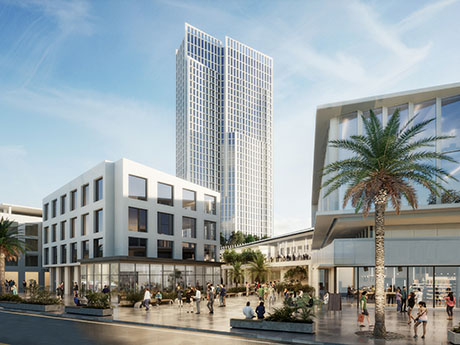— By Megan Husic —
For a long time, Las Vegas could not seem to attract major sports venues due to fear of sports gambling. But perceptions changed and opportunity skyrocketed when the supreme court struck down the federal law that prohibited sports gambling outside of Nevada in 2018, allowing other states to open sports books. Perception about major sports in Las Vegas seemed to change almost overnight.
Since 2017, Las Vegas has attracted successful NHL and WNBA franchises, lured the Raiders from Oakland, Calif., and hosted high-profile events like the NFL draft, Super Bowl, the NCAA men’s Final Four and a Formula 1 Grand Prix. Now, Major League Baseball is on deck as Vegas is currently making plans to develop a $1.5 billion stadium at a site that included the former Tropicana hotel, which is due to be demolished later this year in anticipation of the stadium.
Identifying Property with Potential
Many sites along the Las Vegas Strip have been developed since the early 1960s. In some instances, these sites have been redeveloped several times over. In the environmental world, redevelopment sites typically occur on brownfields, defined by the U.S. Environmental Protection Agency (EPA) as a property, expansion, redevelopment or reuse project that may be complicated by the presence or potential presence of a hazardous substance, pollutant or contaminant. Brownfields can be excellent investment opportunities if you perform thorough due diligence and understand the risks of each site. Many potential sites exist in desirable locations or emerging areas and present ideal development potential, save for the potential environmental issues.
The 61-acre development at Symphony Park in Downtown Las Vegas is a classic example of a brownfield project done right. Once the home to a Union Pacific Railroad maintenance yard with significant legacy environmental issues, it brought the Smith Center and world-class arts and entertainment to the city, not to mention culture, science and medicine.
The Water Street District in downtown Henderson is another great example of a successful brownfield project. Once a blighted neighborhood and commercial area, it is now a downtown core with a collection of retail, professional services, family and nightlife entertainment, employment centers and educational opportunities. Let’s not forget about the America First Center, situated off Water Street, which is the official practice facility of the Henderson Silver Knights. Brownfield redevelopment restores a sense of place, and a place to call home.
Brownfields were once a scary proposition — some too risky to touch. But it has been continually been proven that the perception of risk can be greater than the reality (with proper due diligence). Even heavily contaminated properties like Symphony Park demonstrate that brownfields can be successfully rehabilitated on a large scale.
Plan for the Unexpected
Nobody likes surprises when it comes to real estate redevelopment. That’s why it’s often advantageous to align with an environmental consulting firm that has experience in environmental risk management solutions and development projects complicated by environmental issues. It’s easy to see why investors and developers are attracted to Las Vegas as the city re-invents itself (again) as the sports capital of the world. However, it’s also easy to see that it’s more important than ever for those redevelopers to be prepared. Sometimes these seemingly innocuous development sites reveal environmental surprises, including buried underground storage tanks, desert dumping and asbestos/hazardous building materials in existing structures, to name a few.
Surprises hold up projects and make manageable issues less manageable. Identifying environmental risks before acquiring properties is critical, as is assigning potential cleanup costs to these risks. Depending on the nature of the transaction, these items are often useful as leverage during negotiations.
Finding the Right Support Keeps Your Redevelopment on Track
The most important risk management strategy is a thorough understanding of the site’s environmental issues, as well as how those issues can impact your redevelopment plans and bottom line. It is critical to have environmental and legal support experienced in identifying, anticipating and managing risks on brownfields.
With proper planning and the help of a qualified environmental consultant, the mitigation or remediation of these impacts can be incorporated into the acquisition and development processes. The result? It can be a vibrant, profitable project that is protective of human health and the environment.
Based on experience, these considerations should be worked into any potential (re)development opportunity:
• Always perform a Phase I Environmental Site Assessment (ESA) before a property transaction. This helps satisfy all appropriate inquires (AAI) and can protect the purchaser from environmental liability.
• If environmental issues are identified in the Phase I ESA, completing a Phase II investigation is worth the peace of mind that they provide to developers and lenders.
• Asbestos and lead-based paint should be assessed prior to acquisition, and especially before renovation/demolition. Having an understanding of potential impacts from asbestos and/or lead will help you prepare and better negotiate the closing costs.
• Remember that environmental management is more than just Phase Is and IIs. It can include mitigation tools, such as purchase contract language, environmental insurance, environmental covenants and financial assurances, to name a few.
— Megan Husic, Project Manager, SCS Engineers in Henderson, Nev.


